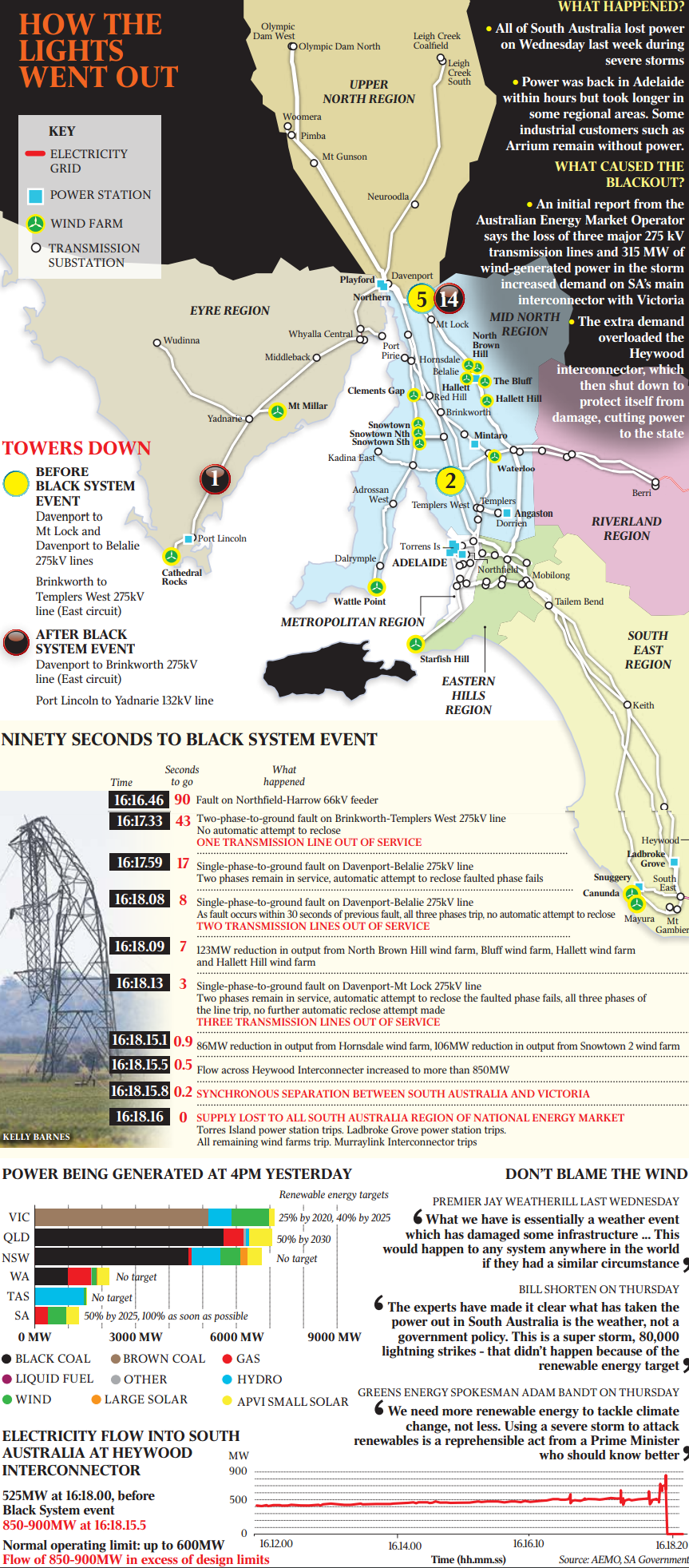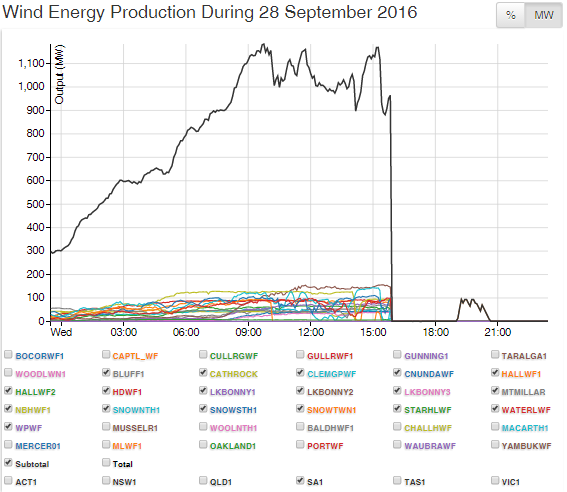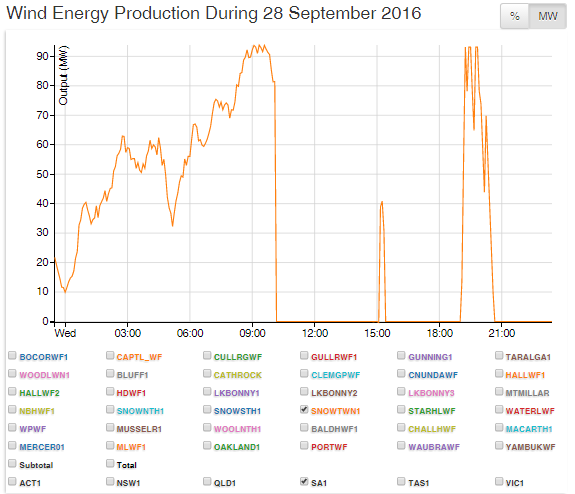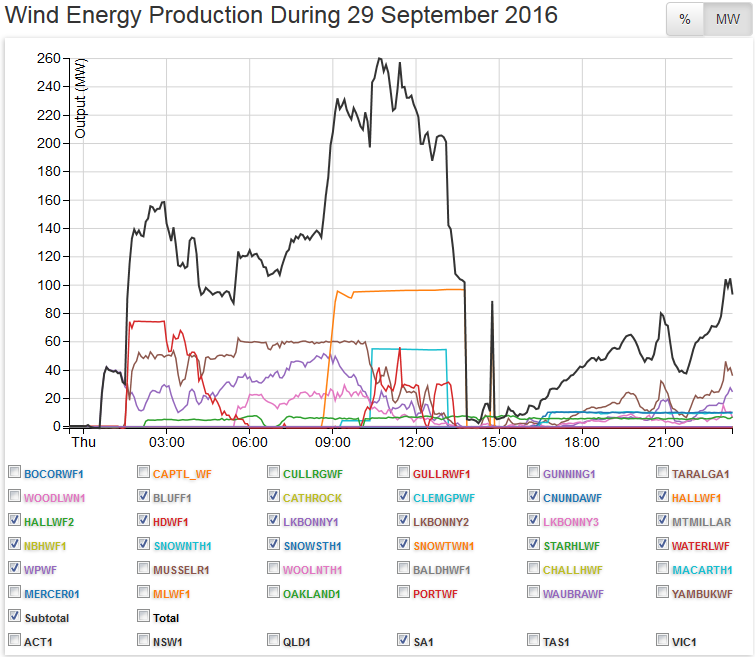For STT, laying out the facts that disclose the greatest environmental and economic fraud of all time has been a labour of love.
When we kicked off on Boxing Day 2012, STT was a lone voice in a vast wilderness: almost every man or woman claiming the mantle ‘journalist’ had ‘drunk the Kool-Aid’ – and if not an actual card-carrying member of the wind cult, almost every one of them championed the cause of wind power or they were simply dying to engage in what became a ‘look-at-me’ routine of public virtue signalling and moral posturing in print and over the airwaves.
Journalists piled in on a wanton love-fest: not only could these things do no wrong, anyone who had the temerity to say so was hounded and vilified by their peers for their troubles – over the last week or two the ABC’s Chris Uhlmann has copped a pasting for doing nothing more than pointing out the obvious fact that wind power is intermittent and unreliable (see this foaming-at-the-mouth diatribe from Ruin-Economy).
If journalism is simply an extension of politics – and given that the media’s practice of ‘churnalism’ involves little more than rehashing ministerial press releases, it probably is – then politicians divided into much the same camps: one or two lone wolves who understood what a so-called wind powered future would look like; and the majority who were not only wedded to the delusion that the world was about to run on breezes, but staked their political existence on it, by signing their nations or states up to policies that amount to economic suicide pacts.
Well, as they say, a week is a long time in politics; and, ergo, it’s been a veritable aeon among the media wolf-pack.
In the week following the aftermath of South Australia’s statewide blackout, the ranks of the few journalists who get it, has gone from a handful to a legion.
When STT pumped out its analysis of what has become known as SA’s ‘Black Wednesday’ before breakfast the following day, the media pack were groping around in the dark (literally in South Australia) for answers as to the cause.
Not to say ‘we told you so’, but ‘we told you so’ – the analysis pitched up on this page – Another Statewide Blackout: South Australia’s Wind Power Disaster Continues – was not only short, sharp and to the point, it was absolutely correct.
It took the Australian Energy Market Operator (AEMO) the better part of a week to work out what STT had rumbled in a matter of minutes (thanks to its many operatives from the electrical generation crowd and former electrical engineers).
The AEMO – which suffers obvious influence and pressure from wind power outfits like AGL and Infigen – seemed almost reluctant to point out what drove South Australians back to the 18th century.
But, eventually, the facts got out: the AEMO determined that the sudden ‘unexplained’ loss of 315MW of wind power actually triggered the shut down of the interconnectors with Victoria’s coal-fired plant; most of the transmission towers taken out by the storm fell after the blackout began (wind cultists and politicians wedded to wind power still blame the collapse of transmission towers for the blackout); and as wind power is non-synchronous, it was unable to restart the transmission system after the blackout – the full AEMO report is available here: aemo-sa-preliminary-report-at-900am-3-october.
STT has always maintained that it will be facts the kill the wind industry.
Now that Australia’s mainstream media has turned on the wind industry, the game is all but over.
No commercial financial institution is going to lend so much as a penny for the construction of any new wind farms.
The wind industry has been moaning about dreaded “uncertainty” for the best part of four years now (the result of which has been that commercial power retailers have not entered a power purchase agreement with any wind power outfits since about December 2012 – we don’t count the couple of PPAs signed with the ACT government).
Well, if anything, ‘uncertainty’ for hopeful wind power outfits has been displaced with one ‘absolute certainty’ as a result of SA’s date with the Dark Ages: the Federal Government’s Large-Scale Renewable Energy Target will never be met; instead, retail power customers will be hit with the $65 per MWh penalty charge under the LRET (a Federal tax on power consumers worth $1.5 billion each year until 2030 – see our post here); and, once that fact gets out, whichever government is in power will be forced to slash the LRET’s annual 33,000GWh target, once again, to save its political skin.
In the meantime, STT is happy to sit back and watch politicians, both State and Federal, squirm as mainstream journalists begin, at long last, to do what their calling is supposed to do: spell out the truth, just like this.
Energy operator: loss of wind power triggered SA outage
The Australian
Michael Owen
6 October 2016
A dramatic loss of wind power helped trigger South Australia’s statewide blackout when the interconnector with Victoria subsequently became overloaded, the first report into the power crisis has revealed.
The Australian Energy Market Operator found storms caused multiple transmission faults, including the loss of three major 275-kilovolt lines north of Adelaide in the space of 12 seconds.
Generation was initially maintained but “following an extensive number of faults in a short period (seconds), 315MW of wind generation disconnected”.
“The uncontrolled reduction in generation resulted in increased flow on the main Victorian interconnector to make up the deficit,” AEMO said.
This resulted in the interconnector overloading and an automatic-protection mechanism tripping the line to protect it from damage, causing the rest of the state to go black.
The report also found key electricity transmission towers blew over after the blackout began last Wednesday afternoon.
The AEMO yesterday confirmed 10 wind farms in South Australia had been ordered to limit generation on an ongoing basis, as it was concerned a failure, or trip, of multiple generators could recur following another disruption to the unstable grid.
Malcolm Turnbull yesterday said Labor Premier Jay Weatherill, who has championed an aggressive green energy policy that forces South Australia to be powered by a more than 40 per cent intermittent renewables mix, had made power unaffordable in the state and he “has to answer for that”.
South Australia’s last coal-fired baseload power station, at Port Augusta, was forced to close in May because of the rise of green power in South Australia, leaving the network at risk of voltage collapse and widespread blackouts, according to transmission company ElectraNet.
Mr Weatherill, who continued yesterday to maintain last week’s statewide blackout was wholly related to severe storms and not linked at all to renewable energy, claimed the Prime Minister was “fearful that he would be blamed for a national electricity market that caused a blackout”.
Mr Weatherill announced a hastily arranged renewable energy summit for today at state parliament.
South Australia’s Climate Change Minister, Ian Hunter, said the summit would “provide accurate and factual information about the role of renewable energy in Australia” ahead of tomorrow’s COAG Energy Council meeting in Melbourne. Opposition energy spokesman Dan van Holst Pellekaan said the summit was “all about spin and feel-good meetings for Premier Weatherill”.
Independent South Australian senator Nick Xenophon yesterday accused Mr Weatherill of being “more ideological than practical”.
But AEMO chief operating officer Mike Cleary said “at this stage we cannot apportion blame”.
“As to whether generation could have or should have managed through those types of faults at this stage is still subject to investigation,’’ he said.
Greg Evans, from the Minerals Council, said South Australia desperately required a “sensible” energy mix to avoid such blackouts.
The Australian
Conservative farm settings blamed for SA energy shutdown
The Australian
Hedley Thomas
6 October 2016
Energy insiders believe the settings on software control systems for up to six key South Australian wind farms were “too conservative”, causing them to shut down unnecessarily in last week’s storm when they should have continued to operate and generate power.
These wind farms suddenly disconnected 315 megawatts of wind generation in an “uncontrolled reduction” at 4.18pm last Wednesday, leading to a statewide blackout, according to the Australian Energy Market Operator’s initial report yesterday.
Another report by AEMO will be released after its exhaustive investigations are completed. But industry insiders say they expected AEMO to find that the six wind farms stopped operating because their control systems were inappropriately set to execute a protective shutdown after a relatively few number of faults, such as lightning strikes, in a couple of minutes.
As the number of faults surpassed the “too conservative” settings, the wind farms failed, triggering an increased demand on the Victorian interconnector, which overloaded and resulted in an “automatic-protection” shutdown, or statewide “Black System”, in a second. An industry expert said yesterday that, in the days since the storm, the control systems of the wind farms which failed had been reset at more realistic levels to ensure they did not fail unnecessarily in future.
“Whether the energy generation is from wind or gas or coal, there are performance standards that have to be met, and in this case they were not met because the settings were too conservative,’’ the senior source said.
“These turbines should have ridden through the faults and met the standard, and they didn’t. They have not performed the way they were meant to in the storm. This will open up questions of liability.”
He said that if the control systems had been set more realistically before the storm — for example, to ride through as many as 50 separate faults in two minutes — there would not have been the sudden loss of 315MW from the six wind farms at a time when there was about 1895MW of demand.
The preliminary report yesterday confirmed that four wind farms — North Brown Hill, Bluff Range, Hallett and Hallett Hill, operated by AGL — went off at 4.18pm, resulting in the first reduction of output (123MW).
Six seconds later, the Hornsdale wind farm went out with a reduction in output of 86MW at the same time as the Snowtown 2 wind farm failed with a 106MW reduction. One second later, supply to all of South Australia was lost.
“Additional analysis is required to determine the reasons for the reduction in generation and observed voltage levels before any conclusions can be drawn,’’ the report says. The market operator also flagged that for its upcoming more detailed report it will conduct modelling and ask market participants for more data and information.
The severe weather from an intense low-pressure system last week inflicted widespread thunderstorms, destructive winds, damaging hail and severe cloud-to-ground lightning strikes in South Australia.
AGL Energy chief Andy Vesey hinted at a control systems scenario on Tuesday when he told a Melbourne energy conference “the situation that needs to be examined is whether the protection system could have been different, which would have then limited the outage and you would then never have had this cascading effect”.
An AGL spokesman told The Australian yesterday: “AGL continues to review the AEMO interim report. We believe the issue is more likely to be about grid protection settings than any particular type of generation.”
The Australian
AGL Chief, Andrew Vesey is clearly gilding the lily with his line about the problem being one of ‘system’ control and the AGL spinner’s line about the problem having nothing to do with ‘any particular type of generation’ is precisely what’s expected from a crowd that built the bulk of SA’s wind power capacity and is still keen to wallow in the LRET subsidy trough.
Again, though, the facts tend to undo the spin.
It is now a given that the forced shut down of 315MW of wind power output caused the complete collapse of SA’s grid, and it is unarguable that wind turbines were shut down as wind speeds increased on Wednesday, 28 September.
Take Snowtown 1, for example; which we have isolated in the graph above – care of Aneroid Energy.
While AGL went to great lengths to point the finger elsewhere and the AEMO played Sherlock Holmes, looking for clues as to why 315MW of wind power output went missing, the answer, as STT followers are well aware, is that wind turbines automatically shut down when wind speeds exceed 25m/s (90km/h, 55mp/h or 48 knots), which it most certainly did on Wednesday, 28 September 2016.
At 9:00 am, Snowtown 1 is merrily producing close to 100% of its installed capacity of 99 MW. On 28 September one thing that South Australia wasn’t short of was wind, which reached gale force across the State, without relent: the hills at Snowtown were being buffeted by wind clocking over 100km/h throughout the day.
Notwithstanding an abundance of wonderful ‘free’ wind energy it was a complete ‘down tools’ at Snowtown 1 at 10:30am – with no return to work until 3:00pm; and then only for a 40MW spurt lasting a few minutes. That minor spurt occurred about 35 minutes before the entire grid went down. At 6:30pm there was another burst of activity, until just before 9:00pm; but, apparently the wind got the better of them, and Snowtown 1 was out for the rest of the day.
Wind turbines do not supply themselves with power to operate their internal control systems, that comes from the grid; and when the grid collapsed there was no power to control turbines, such that they could not be restarted even if the operators wanted to.
Even when the grid was back up and running in most parts the following day, the bulk of SA’s wind power capacity lay idle as winds continued to buffet the State:
On 28 September, long before the total collapse of the grid, SA’s wind farm operators were shutting down their whirling wonders – and mostly kept them shut down the following day – to prevent them from self-destruction, of the kind seen in this video:
***
Over the next few posts, STT is going to rest on its laurels while we run a series of pieces from the mainstream press that have done as much damage to the wind industry as a thumping breeze can do to a turbine with a failed yaw control.
It’s been years in the making, but STT predicts that the wind industry will never recover from the way the mainstream media has turned on it – in the space of a week – and all because it failed to do what meaningful power generation sources are required to do: deliver.

Can I have a show of hands, now? Anyone? No?





Damm it …….just when you think victory in sight, the CEC releases the big guns;
Pretty Boy with the women of renewables singing the new CEC anthem
“Simply Renewable.”
https://vimeo.com/141856542
A web of misinformation has developed into one almighty webbed trampoline mat with everyone involved in the deceit and misinformation bouncing back and for up and down and around in circles trying to extricate themselves from it.
All they are doing is making it more dense and soon it will become so dense they can no longer continue to try and extricate themselves and they will then have to weather the blame and seek help to unravel the disaster they have created by ignoring the years of warnings of the disaster to come, instead following a line of greed, stupidity and thoughtless ideology.
We can only hope they will learn from their mistakes – and I say ‘can only hope’ because there is no certainty they will ever learn.
Hi,
I started a petition “SA PREMIER JAY WEATHERILL : Demand the RESIGNATION of the Energy Minister for HIGH POWER PRICES CAUSING SA’s JOBS CRISIS and 15,000 household POWER DISCONNECTIONS, frequent POWER BLACKOUTS and the JULY 2016 POWER CRISIS” and wanted to see if you could help by adding your name.
Our goal is to reach 100 signatures and we need more support.
You can read more and sign the petition here:
https://www.change.org/p/sa-premier-jay-weatherill-demand-the-resignation-of-the-energy-minister-for-high-power-prices-causing-sa-s-jobs-crisis-and-also-15-000-household-power-disconnections-frequent-power-blackouts-and-the-july-2016-power-crisis?recruiter=135406845&utm_source=share_petition&utm_medium=email&utm_campaign=share_email_responsive
Please share this petition with anyone you think may be interested in signing it.
Thankyou for your time.
Please, Please can anybody HELP!!
Further to our plea our group is trying to STOP TRUSTPOWER NZ from littering the Eastern Mount Lofty Ranges with up to 114 165m tall wind turbines. The court won’t accept lay witnesses. The fact that we have lived here for many years and know the area,the animals and birds, the destruction of fire and the fickleness of the weather doesn’t count.
We can’t rely on recent storm events to quash any further turbine developments.
We need expert witnesses in the following fields :-
1. Rural Land Valuation- of course house prices will fall
2. Electrical,mechanical and/or Civil Engineering- 165m towers in strong winds??
3. Firefighting and Fire risk Assessment-bombers wont come
4. Acoustics- my main fear
5. Health- problems already appearing with the stress
6. Landscape Architecture- stating the bleeding obvious
7. Planning- council matters
8. Ecology, Natural Resource Management – habitat destruction of listed flora and fauna
9. Anthropology- destruction of many years of Aboriginal habitation
10. Heritage and History- currently Mt Lofty Ranges is applying for a World Heritage Agrarian Landscape bid
11. Geohydrology, Geology and Geomorphology- blasting willy nilly in the rock would create problems affecting both underground and surface water quality and supply
12. Meteorology- wind turbines only 40% efficient
13. Industrial Design- can they withstand big storms?
14. Sociology- The human costs
15. Economics-Costs vesus Benefit
Any Help on these matters would be greatly appreciated. The contact is at stopkeynetonwindfarm@hotmail.com If we can STOP this we can STOP more.
Yours sincerely Sally Vance EMLRLG
Errata The email address for EMLRLG should read keynetonwindfarm@hotmail.com
Deliberate is stretching things. The lack of stability of the wind turbines themselves, on top of their zero contribution to overall grid stability, is what brought the whole state down.
Deliberate implies that the wind turbines were capable of performing better than they did. Maybe if they had (additional cost) synthetic inertia circuitry like those mandated in Quebec, Canada, then things may have gone better but we will never know.
Dig a little deeper, Analitik. The wind farms that were shut down before the worst of the front hit had a common feature: all or at least most of them were Suzlon s88s – as to their ‘performance’ see our post here:
The s88s at Hallett/Jamestown and at Snowtown 1 (which was shut down at 10.30am as the first front hit) are notoriously unreliable and, our insiders tell us, literally falling apart. The major repairs are no longer done by Suzlon (aka Senvion) but by Vestas, who look after the V90s at Waterloo. Their mechanics have told our operatives that the s88 is a death trap and the worst built turbine they have worked on.
In many cases, the operators are leaving them idle for long periods after failures of gearboxes/bearings/generators as the cost is in the hundreds of thousands and they are long out of warranty (apparently they wait until there are several out of action so that the cost of the crawler crane can be spread over the repair of several units at once).
So, we’ll stick with ‘deliberate’, at least in respect of the Suzlon s88s involved. Of course, the ‘automatic’ shut down of turbines is ‘deliberate’ in the sense that the onboard systems feather the blades, apply the brakes and ensure the nacelle faces into the wind as soon as wind speeds approach 25m/s. The spin around that has already started: Chris Uhlmann on Insiders yesterday was parroting a line about the shut down being due to a ‘software problem’. Hmmm…
Fun fact: The ABC’s Chris Uhlmann is married to Labor MP, Gai Brodtmann – the federal Member for Canberra. Only last year she referred to wind farms as a “no brainier” and described turbines as, “beautiful, majestic and quiet.”
Awkward….
You may be aware that the NSW Government intends to ‘invest’ $10 billion (that’s right, billion) to build more wind farms.
Every NSW resident needs to contact his/her state politician and object strenuously. Also, could STT run an article on the NSW nonsense?
Keep up the good work and thanks for your persistence.
Well done STT. Your tenacity has paid off. Don’t stop kicking until the wind industry finally stops trying to get up. Cheers to you all!
Even then still keep kicking, just in case there is a breath of wind still left in them.
Wind Turbines are Novelty Energy….and the “Novelty”, has Worn Off! We LOVE you, STT!
Well done STT.
It has been a long hard road but it seems that we might win in the end.
To borrow your line We Will Prevail.
To watch Vapid Jay duck and weave is truly delicious and where is his Brainless sidekick Turbo Tommy he seems to be hiding. Some of the better journalist have got the story very straight. Judith Sloan and Chris Kenny are outstanding and Chris’s exchange tonight with Michaela Cash was spot on, pointing out that the Federal government’s 23% LRET was more than enough to destroy SA’s once affordable reliable Base Load generation and that the 33,000 GWh target by 2020 will never happen.
Keep up the good work STT for the sake of the whole country. We Must Prevail and send the Wind Weasels packing.
Beware, journalists are almost as fickle as politicians. Neither dabble in reality for long.
STT has been telling Governments about what’s happening in power markets and plenty has been written to make these people aware of what a joke wind power is. It shouldn’t take much for them to work that out.
We take our hat off to you STT. We the masses that opposed Senvion and their busted arse Ceres project to put 199 turbines on South Australia’s Yorke Peninsula amongst our prime agricultural cropping country are forever indebted to you.
This project has been in our midst for over eight years and the damage done to the community by the proponents has been devastating.
While one can never say never the chances are now thankfully remote of it ever going ahead. In the early years our only guide in understanding how wind farms work was STT.
Last weekend I saw the movie “Snowden”, I’m not sure whether STT would be happy to be likened to Ed Snowden but there are similarities. Snowden if the film is a true portrayal was a highly intelligent man that collected meta data for the secret services in the US however became whistle blower when he realised the rights of ordinary citizens was being compromised by their own govt.
I’m sure STT has put in many hundreds of hours in this battle, with no monetary reward and no premiership medal at the end of it. We know the strain it puts on individuals and families, so we can only imagine what you have been through.
However as you remain in anonymity remember my friend you will always walk tall amongst the greats that fought for truth and justice.
Have a drink on Marty.
We desperately need whistleblowers from within the wind industry to come forward en masse. We also need a Wikileaks release on this wind turbine issue as well as more releases of the manipulating climate change alarmism scheming directly related to industrial wind turbines as mitigation.